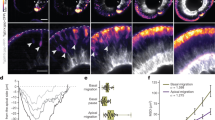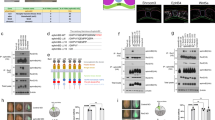Abstract
An important step in retinal development is the positioning of progenitors within the eye field where they receive the local environmental signals that will direct their ultimate fate1. Recent evidence indicates that ephrinB1 functions in retinal progenitor movement, but the signalling pathway is unclear. We present evidence that ephrinB1 signals through its intracellular domain to control retinal progenitor movement into the eye field by interacting with Xenopus Dishevelled (Xdsh), and by using the planar cell polarity (PCP) pathway. Blocking Xdsh translation prevents retinal progeny from entering the eye field, similarly to the morpholino-mediated loss of ephrinB1 (ref. 2). Overexpression of Xdsh can rescue the phenotype induced by loss of ephrinB1, and this rescue (as well as a physical association between Xdsh and ephrinB1) is completely dependent on the DEP (Dishevelled, Egl-10, Pleckstrin) domain of Xdsh. Similar gain- and loss-of-function experiments suggest that Xdsh associates with ephrinB1 and mediates ephrinB1 signalling through downstream members of the PCP pathway during eye field formation.
This is a preview of subscription content, access via your institution
Access options
Subscribe to this journal
Receive 12 print issues and online access
$209.00 per year
only $17.42 per issue
Buy this article
- Purchase on Springer Link
- Instant access to full article PDF
Prices may be subject to local taxes which are calculated during checkout





Similar content being viewed by others
References
Saha, M. S. & Grainger, R. M. A labile period in the determination of the anterior-posterior axis during early neural development in Xenopus. Neuron 8, 1003–1014 (1992).
Moore, K. B., Mood, K., Daar, I. O. & Moody, S. A. Morphogenetic movements underlying eye field formation require interactions between the FGF and ephrinB1 signaling pathways. Dev. Cell 6, 55–67 (2004).
Kenyon, K. L., Zaghloul, N. & Moody, S. A. Transcription factors of the anterior neural plate alter cell movements of epidermal progenitors to specify a retinal fate. Dev. Biol. 240, 77–91 (2001).
Maurus, D. et al. Noncanonical Wnt-4 signaling and EAF2 are required for eye development in Xenopus laevis. EMBO J. 24, 1181–1191 (2005).
Cavodeassi, F. et al. Early Stages of Zebrafish Eye Formation Require the Coordinated Activity of Wnt11, Fz5, and the Wnt/beta-Catenin Pathway. Neuron 47, 43–56 (2005).
Holland, S. J. et al. Bidirectional signalling through the EPH-family receptor Nuk and its transmembrane ligands. Nature 383, 722–725 (1996).
Davy, A., Aubin, J. & Soriano, P. Ephrin-B1 forward and reverse signaling are required during mouse development. Genes Dev. 18, 572–583 (2004).
Cowan, C. A. & Henkemeyer, M. Ephrins in reverse, park and drive. Trends Cell. Biol. 12, 339–346 (2002).
Palmer, A. & Klein, R. Multiple roles of ephrins in morphogenesis, neuronal networking, and brain function. Genes Dev. 17, 1429–1450 (2003).
Tanaka, M., Kamo, T., Ota, S. & Sugimura, H. Association of Dishevelled with Eph tyrosine kinase receptor and ephrin mediates cell repulsion. EMBO J. 22, 847–858 (2003).
Sheldahl, L. C. et al. Dishevelled activates Ca2+ flux, PKC, and CamKII in vertebrate embryos. J. Cell Biol. 161, 769–777 (2003).
Huang, S. & Moody, S. A. The retinal fate of Xenopus cleavage stage progenitors is dependent upon blastomere position and competence: studies of normal and regulated clones. J. Neurosci. 13, 3193–3210 (1993).
Yang-Snyder, J., et al. A frizzled homolog functions in a vertebrate Wnt signaling pathway. Curr. Biol. 6, 1302–1306 (1996).
Kinoshita, N., Iioka, H., Miyakoshi, A. & Ueno, N. PKCδ is essential for Dishevelled function in a noncanonical Wnt pathway that regulates Xenopus convergent extension movements. Genes Dev. 17, 1663–1676 (2003).
Moody, S. A. Fates of the blastomeres of the 32-cell-stage Xenopus embryo. Dev. Biol. 122, 300–319 (1987).
Habas, R., Kato, Y. & He, X. Wnt/Frizzled activation of Rho regulates vertebrate gastrulation and requires a novel Formin homology protein Daam1. Cell 107, 843–854 (2001).
Umbhauer, M. et al. The C-terminal cytoplasmic Lys-thr-X-X-X-Trp motif in frizzled receptors mediates Wnt/beta-catenin signalling. EMBO J. 19, 4944–4954 (2000).
Winklbauer, R., Medina, A., Swain, R. K. & Steinbeisser, H. Frizzled-7 signalling controls tissue separation during Xenopus gastrulation. Nature 413, 856–860 (2001).
De Calisto, J. et al. Essential role of non-canonical Wnt signalling in neural crest migration. Development 132, 2587–2597 (2005).
Moody, S. A. Cell lineage analysis in Xenopus embryos. In Methods in Molecular Biology: Dev. Biol. Protocols, R. S.Tuan, and C. W.Lo, eds. (Totowa, NJ: Humana Press, Inc), 331–347 (1999).
Wallingford, J. B. et al. Dishevelled controls cell polarity during Xenopus gastrulation. Nature 405, 81–85 (2000).
Chin-Sang, I. D. et al. The ephrin VAB-2/EFN-1 functions in neuronal signaling to regulate epidermal morphogenesis in C. elegans. Cell 99, 781–790 (1999).
Himanen, J. P. et al. Crystal structure of an Eph receptor-ephrin complex. Nature 414, 933–938 (2001).
Sive, H. L., Grainger, R. M. & Harland, R. M. Early development of Xenopus laevis: A Laboratory Manual. Cold Spring Harbor, NY: Cold Spring Harber Laboratory Press (2000).
Smith, J. C. et al. Expression of a Xenopus homolog of Brachyury (T) is an immediate-early response to mesoderm induction. Cell 67, 79–87 (1991).
Itoh, K. & Sokol, S. Y. Graded amounts of Xenopus dishevelled specify discrete anteroposterior cell fates in prospective ectoderm. Mech. Dev. 61, 113–125 (1997).
Small, E. M. et al. Developmental expression of the Xenopus Nkx2-1 and Nkx2-4 genes. Mech. Dev. 96, 259–262 (2000).
Heller, N. & Brandli, A. W. Xenopus Pax-2/5/8 orthologues: novel insights into Pax gene evolution and identification of Pax-8 as the earliest marker for otic and pronephric cell lineages. Dev. Genet. 24, 208–219 (1999).
Hirsch, N. & Harris, W. A. Xenopus Pax-6 and retinal development. J. Neurobiol. 32, 45–61 (1997).
Mathers, P. H., Grinberg, A., Mahon, K. A. & Jamrich, M. The Rx homeobox gene is essential for vertebrate eye development. Nature 387, 603–607 (1997).
Zygar, C. A., Cook, T. L. & Grainger, R. M., Jr. Gene activation during early stages of lens induction in Xenopus. Development 125, 3509–3519 (1998).
Smith, W. C., McKendry, R., Ribisi, S., Jr. & Harland, R. M. A nodal-related gene defines a physical and functional domain within the Spemann organizer. Cell 82, 37–46 (1995).
Chong, L. D. et al. Fibroblast growth factor receptor-mediated rescue of x-ephrin B1-induced cell dissociation in Xenopus embryos. Mol. Cell. Biol. 20, 724–734 (2000).
Murakami, M. S., Moody, S. A., Daar, I. O. & Morrison, D. K. Morphogenesis during Xenopus gastrulation requires Wee1-mediated inhibition of cell proliferation. Development 131, 571–580 (2004).
Acknowledgements
We thank R. Moon for Xdsh and Xwnt5a (RPA) constructs; N. Kinoshita for PKCδ1, PKCδ2 constructs; S. Sokol for DN Tcf3 construct; L. Heasley for MKK7–JNK1 fusion construct; T. Yamaguchi for Daam1 MO; J. Gautier for tPARP construct; R. Winklbauer for Xfz7, ΔC Xfz7 constructs; K. Itoh and J. Miller for Xdsh–GFP constructs; P. McCrea for Xwnt11, DN Xwnt11 constructs and D. Morrison for cdc25c and anti-polyoma antibody. We also thank J. Acharya, S. Sharan, and M. Fortini for helpful discussions and critical reading of this manuscript. This research was supported by the Intramural Research Program of the National Institutes of Health (NIH), National Cancer Institute, and NIH EY10096.
Author information
Authors and Affiliations
Corresponding author
Ethics declarations
Competing interests
The authors declare no competing financial interests.
Supplementary information
Supplementary Information
Supplementary figures S1, S2, S3 and S4 (PDF 937 kb)
Rights and permissions
About this article
Cite this article
Lee, HS., Bong, YS., Moore, K. et al. Dishevelled mediates ephrinB1 signalling in the eye field through the planar cell polarity pathway. Nat Cell Biol 8, 55–63 (2006). https://doi.org/10.1038/ncb1344
Received:
Accepted:
Published:
Issue Date:
DOI: https://doi.org/10.1038/ncb1344
This article is cited by
-
Sprouty2 regulates positioning of retinal progenitors through suppressing the Ras/Raf/MAPK pathway
Scientific Reports (2020)
-
EphrinB1 promotes cancer cell migration and invasion through the interaction with RhoGDI1
Oncogene (2018)
-
TBC1d24-ephrinB2 interaction regulates contact inhibition of locomotion in neural crest cell migration
Nature Communications (2018)
-
EphrinB2 affects apical constriction in Xenopus embryos and is regulated by ADAM10 and flotillin-1
Nature Communications (2014)
-
Eph-dependent cell-cell adhesion and segregation in development and cancer
Cellular and Molecular Life Sciences (2012)



